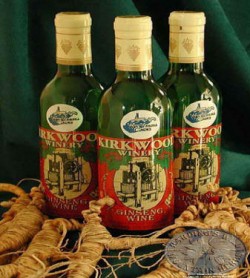Wine, Ginseng – Ginseng Wine
September 18, 2014What’s the strangest wine you’ve ever tasted?
This weekend at the Kirkwood Winery Grape Stomping Festival, you can taste all the flavors of the mountains. Their wines reflect Appalachian traditions, bottling plants tastes that have been beloved here for generations.
Their distinctly West Virginia wines include ramp, blackberry, wild elderberry and rhubarb. But one of their most unique is ginseng wine.
Ginseng is a prized plant that grows in Southern WV. But it’s threatened, so harvesting it is a careful task.
What is Ginseng?
Ginseng is an herb that grows in all the counties of Southern West Virginia.
According to folklore, ginseng is said to have healing properties— curing colds, lowering fatigue and prolonging your life. Kirkwood Winery calls it an aphrodisiac.
There isn’t proof that it does any of these things. But many people still enjoy ginseng in teas, soups, herbal blends and of course, the wine.
Harvesting the herb is a long-standing tradition in the Appalachian region, but because ginseng is very slow to grow, over-harvesting has threatened it.
However, you can still dig ginseng, as long as you follow the rules to help the plant thrive.
Sustainable Harvesting
The plant has a limited harvesting season, scheduled around the maturation of the plant. Plucking it before it matures means it can’t regrow. And immature plants are also less useful, so plucking them early isn’t advantageous.
But not every ginseng plant is ready to go during the season. The seeds take 2 years to germinate, and the plant can’t reproduce until it’s about 5 years old.
You determine when to pick ginseng by its roots, berries and leaves. A 3-pronged root with at least 15 leaflets should be about the proper age. (Younger plants will have roots too small to be of value.)
The final and most important thing to check on the ginseng plant is its berries. If the berries are red, it’s ready to be harvested. And, those berries are its seeds! When they’re red and ripe, you pull them and plant them in the ground nearby, so you replace the ginseng you take.
The problem
With these methods, ginseng could continue to thrive in West Virginia.
But illegal harvesters sometimes pluck the plants too early, taking off with roots that are smaller and not of much value. By comparison, a mature ginseng plant can be worth money, and local harvesters often supplement their income with responsible harvesting, or “sanging.”
So not only are they destroying this resource for everyone, they are doing so without getting the true value of these natural treasures.
In as little as 25 years, wild ginseng could disappear from our state if this continues.
Law enforcement has cracked down on illegal ginseng harvesting in the past few years, and they encourage people to help save the plant by speaking up about illegal harvesting.
Permits
If you’re interested in harvesting ginseng, you can contact one of the district offices for the Forest Service to ask about a permit.
The Mongahela State Forest is the only public, state-owned land in West Virginia where you can harvest ginseng. Plan your trip in Greenbrier County or Nicholas County and explore Southern WV with our trip planner.
You can also harvest it on private lands, but you need written permission from the land owner.
Selling, growing, keeping and traveling with ginseng out of state require special permits. If you plan to keep it more than a year, you’ll also want to get a weight receipt, so authorities know it wasn’t illegally taken out of season.
But the easiest way to enjoy ginseng is to taste it at Kirkwood Winery!
Have you tried ginseng?


